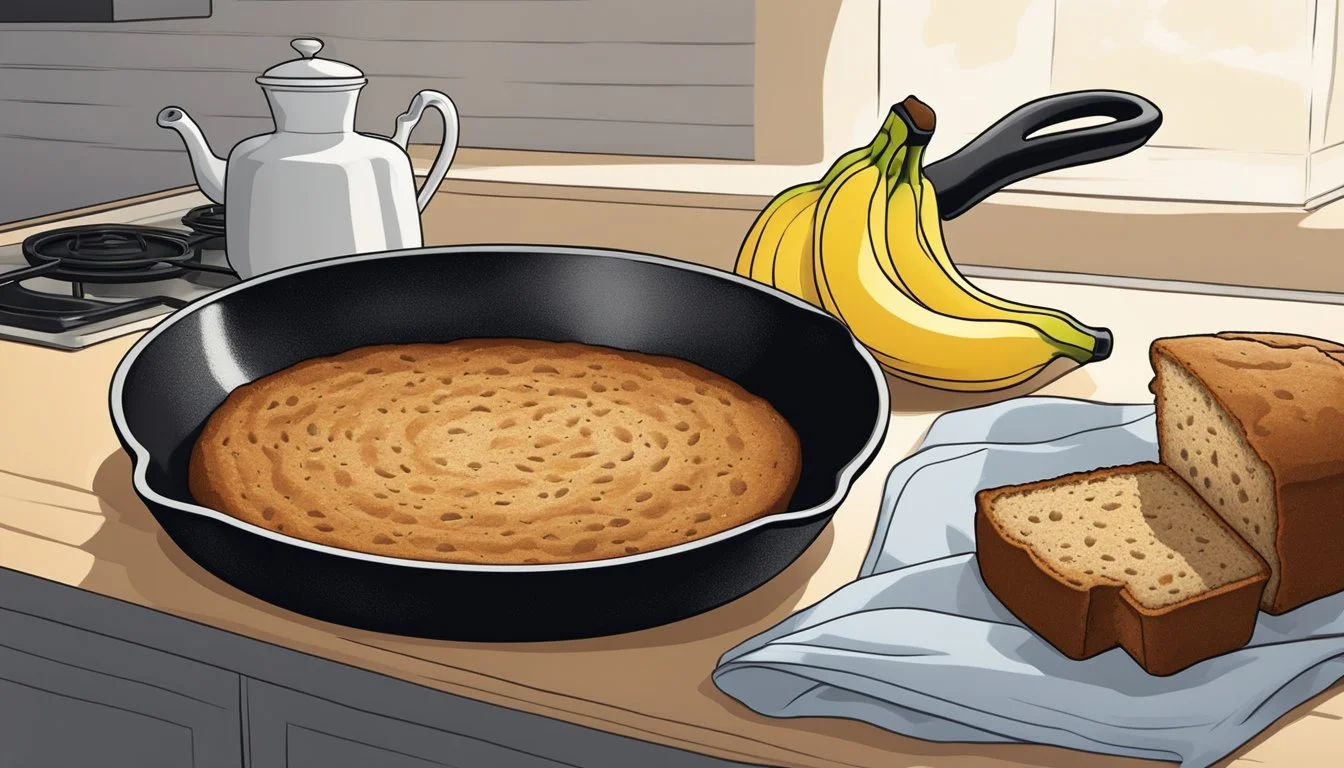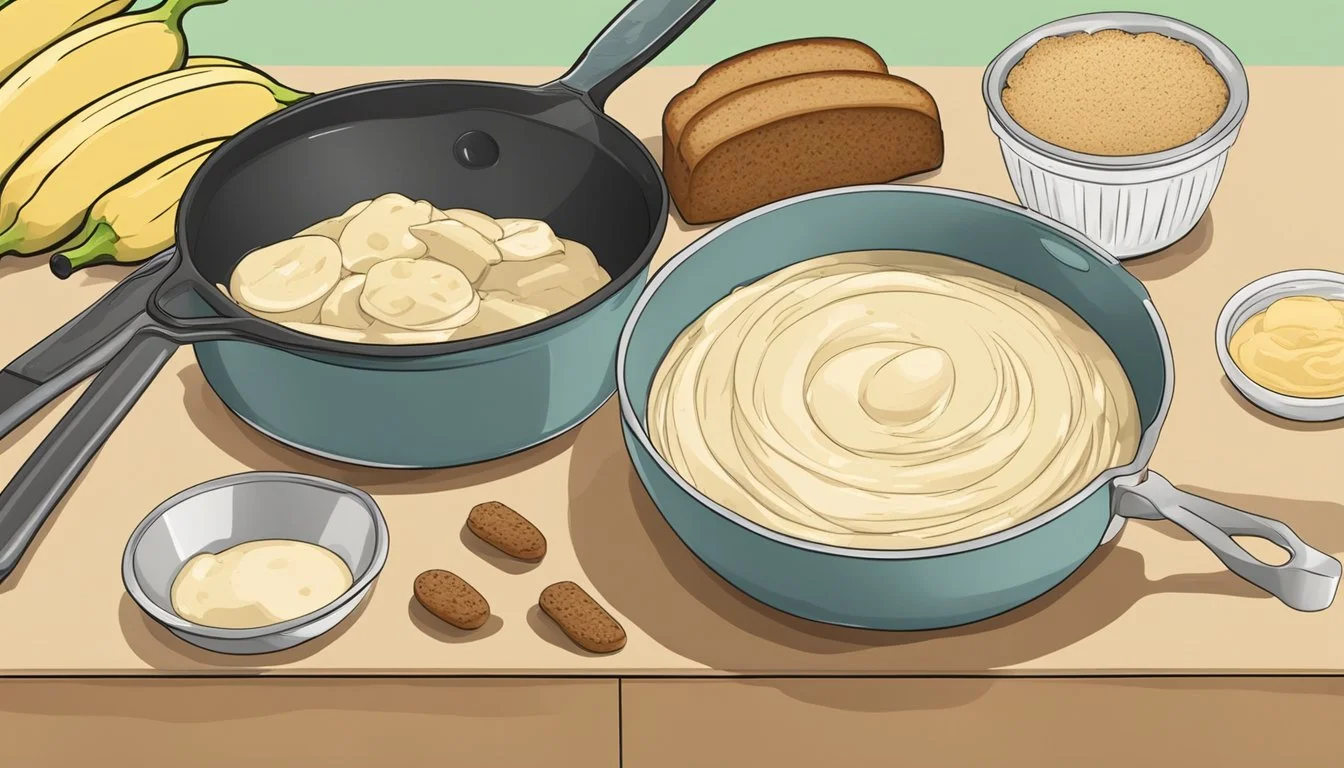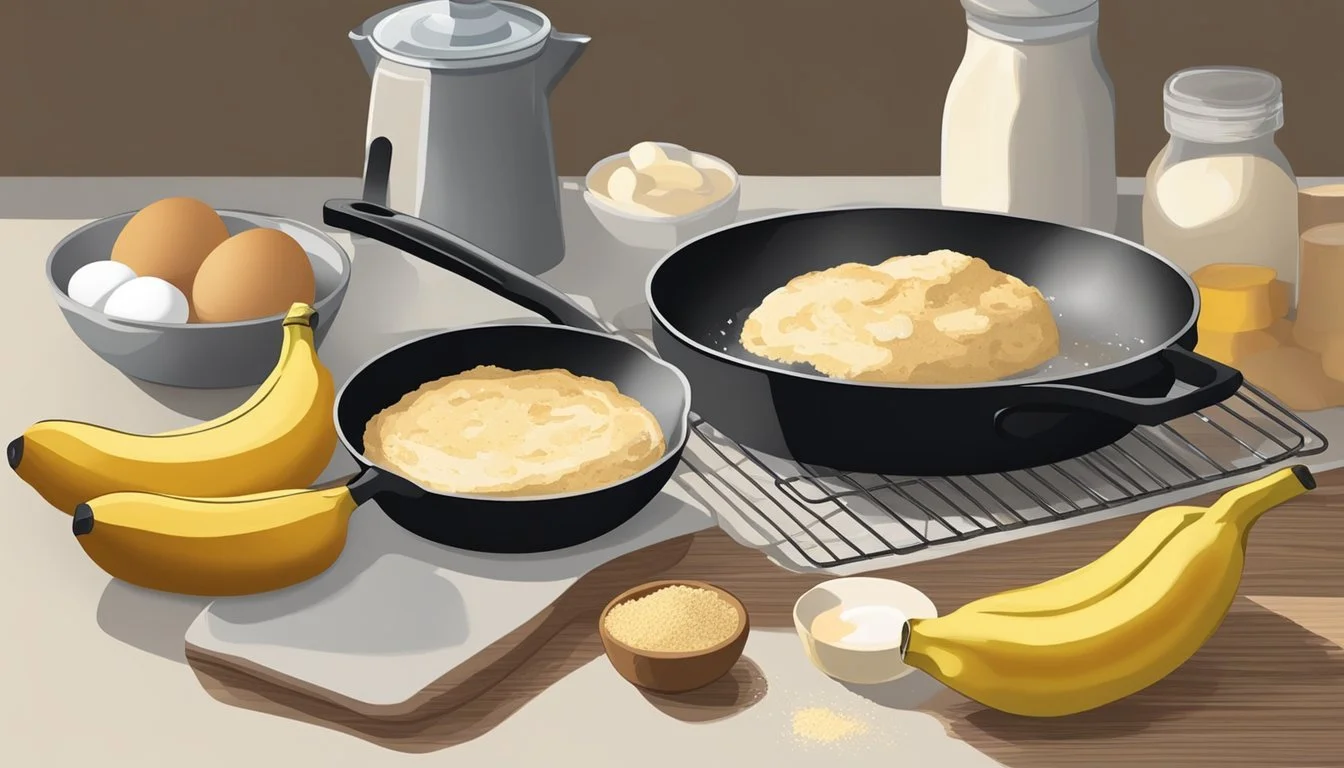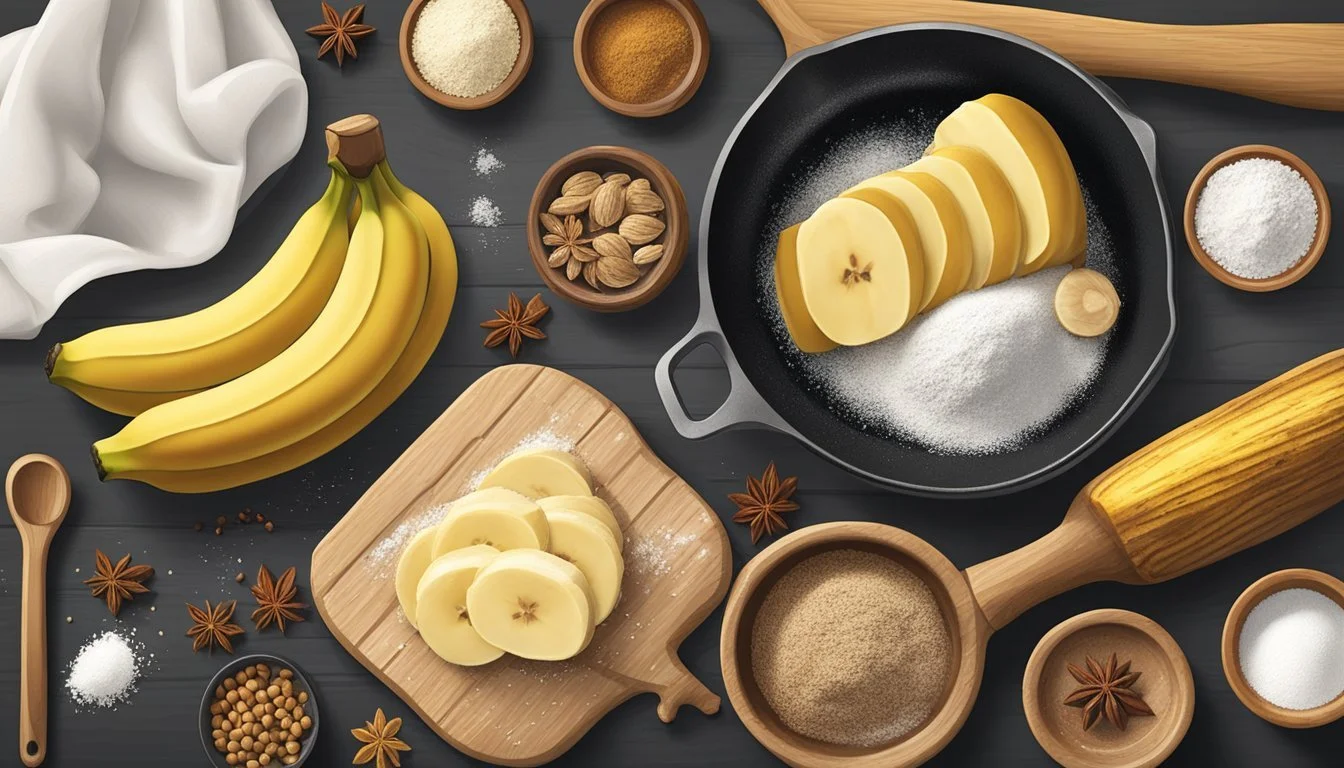The Stovetop Banana Bread Recipe
How to Master Skillet Baking
Banana bread (What wine goes well with bread?) has long been a cherished comfort food, often baked in the traditional oven, filling homes with its sweet, enticing aroma. However, a different method has emerged, bringing a rustic charm and simplicity to the baking process: stovetop banana bread. This skillet-baked treat repurposes the classic loaf into something that can be made without the need for an oven, making it accessible for those with limited kitchen appliances or during warm months when an oven might overheat a household.
The skillet method involves using a cast iron or non-stick pan to create the banana bread, transforming the way heat is distributed throughout the batter. By cooking it on the stovetop, the bread develops a delightful, crispy exterior while maintaining a moist, tender crumb on the inside. This method doesn’t just offer a convenient alternative to oven baking; it also opens up opportunities for customizing the crust’s texture and allows for more direct control over the cooking temperature.
Introducing skillet banana bread is not just about presenting a new recipe, it's about offering a versatile and efficient way of making a beloved treat. This technique is suitable for a variety of settings, from the busy city dweller's small kitchen to a camper's outdoor cooksite, demonstrating how banana bread’s universal appeal can adapt to modern cooking trends and lifestyle needs.
Why Skillet-Baked?
Baking banana bread in a skillet, particularly a cast iron skillet, can significantly influence the texture and flavor of the final product. The heft and heat-retention properties of a cast iron skillet ensure that heat is distributed evenly. This minimizes the potential for undercooked centers or overly browned edges. The even heat contributes to a uniform texture that is beloved in banana bread – a moist center with a slightly firmer crust.
Moreover, the skillet imparts a subtle difference in the crust's flavor profile that one cannot achieve in a traditional oven-baked loaf pan. When preheated with butter or oil, the skillet can bestow a light, crispy edge to the bread, providing a delightful contrast in textures.
The utility of a cast iron skillet extends beyond its baking prowess. These skillets are durable and can last a lifetime with proper care, which includes routine seasoning to prevent rust. Seasoning a cast iron skillet involves coating it with a thin layer of oil and heating it to produce a non-stick surface. This process not only enhances the skillet's performance but also contributes to the infused flavors in dishes cooked in it.
Even heating: Ensures consistent texture
Crispy edges: Offers a contrast in each bite
Flavorful crust: Enhanced by the skillet's seasoning
Longevity: Proper maintenance prevents rust and maintains re-seasoning
Baking banana bread on the stovetop presents a practical solution for those who may lack access to an oven, making it a versatile method in any kitchen. The technique is straightforward, requires minimal equipment, and can bring a fresh dimension to a classic comfort food.
Selecting Your Ingredients
When one sets out to make a skillet-baked treat like stovetop banana bread, the choice of ingredients is foundational to the success of the final dish. A collection of quality components not only contributes to the flavor but also to the bread's texture and overall appeal.
Bananas: The heart of any banana bread recipe lies in the bananas. Selecting overripe bananas is crucial as they are sweeter and more flavorful. The riper the banana, the richer the taste of the bread.
Flour: The structure of the bread is primarily provided by all-purpose flour. This staple ingredient ensures your bread has the perfect crumb and consistency.
Leavening Agents: Baking soda and baking powder are essential to give the bread its rise and airy texture. A balanced combination helps the bread to rise properly without being too dense.
Eggs and Milk: These ingredients add moisture and act as binding agents. Eggs contribute to the overall structure, while milk softens the crumb.
Flavor Enhancers: Vanilla extract, cinnamon, and nutmeg offer warmth and depth to the banana bread's flavor profile. As the spices mingle with the banana, they create an inviting aroma.
Sweetness and Texture: Adding chocolate chips or pecans can introduce delightful contrasts in flavor and texture, but use them according to personal preferences or dietary restrictions.
Salt: A pinch of salt is vital in balancing the sweetness and enhancing the overall flavor palette of the banana bread.
Here’s a summarized list of ingredients for reference:
Bananas: Overripe for enhanced sweetness
Flour: All-purpose flour for structure
Eggs: For binding and moisture
Milk: Softens the crumb
Vanilla Extract: Adds a subtle depth of flavor
Baking Powder & Baking Soda: For leavening
Salt: To balance and enhance flavors
Cinnamon & Nutmeg: Spices that offer warmth
Optional: Chocolate chips or pecans for added texture
Choosing quality ingredients and combining them correctly is the first step to a delicious banana bread baked right on your stovetop.
Preparing Your Skillet
Prior to beginning the baking process, it's crucial that your skillet is properly prepared to ensure even cooking and prevent sticking.
Cleaning the Skillet
The first step in preparing your cast-iron skillet for baking banana bread is ensuring it's clean. Any residue from previous cooking can affect flavor and cooking performance. The skillet should be washed with warm water and a non-abrasive sponge, dried thoroughly to prevent rust, and then given a light coat of oil to safeguard the seasoning.
Wash gently with warm water
Dry immediately to avoid rust
Apply a thin layer of cooking oil
Re-Seasoning if Necessary
A well-seasoned skillet is non-stick and adds depth to the flavors of your banana bread. If food frequently sticks to your skillet or if it looks dull and dry, it may be time to re-season it. To re-season, coat the clean skillet lightly with vegetable oil, and bake it upside down in a preheated oven at 350°F for one hour. Allow it to cool in the oven after the heat is turned off.
Re-seasoning steps:
Apply a thin, even coat of vegetable oil to the skillet.
Place the skillet upside-down on the middle rack.
Bake for an hour and turn off the heat, letting it cool in the oven.
This process not only improves the life span of the skillet but also enhances the cookware's ability to cook food more evenly, essential for a perfect banana bread.
Mixing the Batter
When creating the batter for Stovetop Banana Bread, the process begins by preparing the base of mashed bananas. One must ensure that the bananas are ripe and thoroughly mashed; this step is essential as it contributes both moisture and flavor.
Following the mashing of bananas, one proceeds to incorporate the wet ingredients. Eggs are to be beaten into the banana mixture until fully integrated. To this, melted unsalted butter should be added, alongside the granulated sugar and brown sugar, if a deeper, caramelized flavor is desired. The action of mixing these ingredients not only combines them but also helps to form the foundation of the cake's structure.
Aromatic spices like cinnamon can be introduced to the mix to provide a warm and comforting hint that complements the banana's sweetness. A measure of milk may be incorporated at this stage if a looser batter consistency or additional moisture is preferred.
The dry ingredients, mainly flour, should be sifted to prevent clumps and promote a light, airy texture in the banana cake. The flour is to be added gradually and folded gently into the wet mix to ensure that the batter remains tender, thus avoiding the overdevelopment of gluten.
Key Steps for Mixing Batter:
Mash the bananas to a smooth consistency.
Beat in eggs, then add melted unsalted butter and sugars.
Incorporate milk as needed for desired batter consistency.
Sift and gently fold in flour to maintain a tender crumb.
Mixing the batter requires a delicate balance, maintaining a homogenous blend without overmixing, as it could result in a dense and chewy texture. Hence, mix until just combined for the perfect stovetop banana bread batter.
Baking the Bread
Baking banana bread on a stovetop requires specific heat control and techniques to achieve that oven-baked quality. The cook begins with a preheated skillet and must check for doneness carefully, as the appearance can differ from conventional oven baking.
Oven Temperature and Time
The stovetop method emulates an oven environment using a skillet. The cook preheats the skillet or pot over medium-low heat, which is crucial to evenly bake the bread without burning it. A heavy-bottomed non-stick skillet is ideal to distribute the heat and prevent sticking. Unlike oven baking, where a steady temperature circulates around the batter, the heat source comes from below on a stovetop. Therefore, it's important to use a preheated lid to trap the heat and create an "oven" effect within the skillet. The cook maintains the heat at a consistent level throughout the baking process, which generally takes about 45-60 minutes depending on the skillet's size and material.
Checking Doneness
To check if the banana bread is fully baked, a clean toothpick inserted into the center should come out with a few moist crumbs but no wet batter. If the toothpick is clean with no crumbs, the bread might be overdone. The texture of the bread should be moist, not soggy or dry. Because the stovetop-method banana bread might appear paler than its oven-baked counterpart, visual cues are less reliable. Touch is also a good indicator; the surface should feel firm to the touch, indicating the ingredients have set and formed a proper structure.
The stovetop banana bread offers a unique take on a classic treat, where maintaining an even temperature and vigilant checking for doneness are key to a delicious result.
Serving Suggestions
When serving stovetop banana bread, the accompaniments can enhance the flavors and create a delightful eating experience. Proper storage is also crucial to maintain freshness.
Accompaniments
Banana bread's versatility allows for a range of accompaniments. For a simple yet decadent option, vanilla ice cream pairs exquisitely with a warm slice, letting the ice cream slightly melt into the bread. A drizzle of honey or a dusting of powdered sugar can sweeten each bite without overpowering the banana flavor. For chocolate lovers, scattering chocolate chips on top while the bread is still warm can result in melted pockets of chocolate.
For those who prefer a richer topping, a glaze made from confectioners' sugar and milk, or even a spread of Nutella, can add a luxurious dimension. Serving banana bread as part of a breakfast or brunch? Complement it with a fruit smoothie for a refreshing contrast.
Storage Tips
Storing banana bread correctly ensures it retains its moistness and flavor. Once the bread has cooled completely, it should be wrapped tightly in plastic wrap or aluminum foil. For short-term storage, keep it at room temperature where it will stay fresh for up to two days. For longer storage, place the wrapped bread in the refrigerator, where it can last up to a week.
If one needs to store banana bread for an extended period, freezing is an excellent option. Wrap the bread in plastic wrap followed by a layer of aluminum foil, or place it in a freezer-safe bag. Properly stored, banana bread can be frozen for up to three months. Thaw at room temperature when ready to enjoy again.
Nutritional Considerations
When considering the nutritional aspects of stovetop banana bread, one should account for the ingredients typically used in its preparation. Banana bread is a source of carbohydrates, primarily from flour and bananas. The bananas also contribute vitamins and minerals, such as potassium and vitamin C, and provide dietary fiber.
The average slice of homemade banana bread contains approximately:
Calories: 196-263 kcal
Carbohydrates: 32-43 g
Protein: 2-4 g
Fat: 6-11 g
Fiber: 1-2 g
Note: These values can vary based on ingredient substitutions and serving sizes.
To provide clearer nutrition information, consider the following:
Flour: White flour is commonly used and is a major source of calories and carbohydrates. Whole wheat flour can be used for added nutrients and fiber.
Sugar: This ingredient contributes calories with little nutritional value. Reducing the sugar or using alternatives such as honey may affect the nutritional content.
Eggs: They add protein and fat but also essential nutrients such as vitamin D and choline.
Oil/Butter: A significant source of fat. One may use unsaturated oils or applesauce to reduce saturated fat intake.
Add-ins: Nuts or chocolate chips increase calories and potentially beneficial nutrients, like antioxidants from dark chocolate or healthy fats from nuts.
Banana bread can fit into a balanced diet when consumed in moderation. One should be mindful of portion sizes and ingredient choices to align the banana bread preparation with their nutritional goals.
Variations and Add-Ins
Stovetop banana bread can easily be customized with various add-ins to cater to different taste preferences. Here are some popular variations:
Chocolate Chips: A classic choice, chocolate chips add a delightful sweetness and texture. They can be folded into the batter or sprinkled on top before cooking. Use about 1/2 to 3/4 cup depending on the desired chocolate intensity.
Pumpkin: For a fall twist, one can incorporate pumpkin puree into the banana bread batter. This not only adds a seasonal flavor but also contributes to a moist crumb. Substitute up to half of the mashed banana with pumpkin puree and consider a pinch of pumpkin spice.
Caramel: Swirling caramel into the batter just before pouring it into the skillet infuses the bread with a rich, buttery flavor. Alternatively, drizzle caramel on top of the bread after cooking for a decadent finish.
Pecans: Chopped pecans provide a nutty crunch and enhance the bread's texture. They can be mixed into the batter or added as a topping for extra crunch. About 1/2 cup should suffice.
For those seeking a unique topping:
Streusel: Combine pecans, brown sugar, and cinnamon, then stir in melted butter and flour to create a crumbly streusel. Sprinkle this onto the batter before cooking for a crunchy, sweet layer.
To incorporate these add-ins and variations, simply mix them into the banana bread batter, maintaining the balance with other ingredients. The key is to add flavors and textures while preserving the bread's classic moistness and banana flavor. When experimenting with add-ins, it's important to adjust cooking times as necessary to ensure even baking.
Troubleshooting Common Issues
When preparing stovetop banana bread, bakers may encounter issues affecting texture or skillet condition. The following subsections address these specific areas to ensure successful outcomes.
Bread Texture Issues
Undercooked Center: If the bread's center remains doughy while the exterior is properly cooked, one should lower the burner's heat and extend the cooking time, allowing heat to penetrate more slowly and evenly.
Overmixing Batter: It can lead to a dense bread texture. Mix ingredients until they are just combined to preserve a tender crumb.
Dryness: Should the bread turn out dry, consider adding more bananas or a small amount of yogurt to the batter to enhance moisture.
Moistness Levels: Achieving the right balance of moistness is key. Ensure accurate measurements of ingredients and avoid overbaking, which can rob the bread of its desirable moist texture.
Skillet Maintenance
Seasoning a Cast Iron Skillet: Before baking banana bread, season the skillet to create a non-stick surface and to avoid rust. Apply a thin layer of oil and bake it in the oven.
Cleaning and Storage:
After baking, clean the skillet with hot water and a non-abrasive brush; avoid soap to preserve the skillet's seasoning.
Dry the skillet thoroughly to prevent rust and store it in a dry place.
Regular maintenance ensures the longevity of the skillet and consistent baking results for the stovetop banana bread.
Exploring Banana Bread Recipes
Banana bread is a comforting and versatile sweet treat. Its recipes can vary, but the essential ingredients remain consistent: ripe bananas, a sweetening agent (such as sugar), a fat component (usually butter or oil), eggs, and flour. What makes stovetop banana bread exciting is the ability to bake it without an oven, using just a skillet on a stovetop.
Ingredients of Stovetop Banana Bread:
Ripe Bananas: The base of any banana bread, they should be mashed until smooth.
Eggs: Work as a binder and add moisture to the bread.
Sugar: For sweetness and browning.
Fat: Butter or oil; each adds distinct texture and flavor.
Flour: Usually all-purpose flour for structure.
Leavening Agents: Baking soda and, in some recipes, baking powder for rise.
Flavorings: Vanilla extract and cinnamon are popular choices.
Salt: To balance the flavors.
The process typically consists of mixing wet ingredients with the dry ingredients until a consistent batter forms. Greasing the skillet is a crucial step; it prevents sticking and contributes to the bread's exterior texture. Cooks should first melt butter or warm oil in the skillet before pouring in the batter. Low to medium-low heat is best to ensure even cooking without burning the bottom.
Cooking Times and Techniques:
Preheat the skillet on medium-low heat.
Pour in the batter; cover with a lid or foil to simulate an oven-like environment.
Cooking times may vary, usually between 30 to 50 minutes, depending on skillet and heat level.
The bread is done when a toothpick or knife inserted comes out clean.
One can customize their banana bread by including nuts, chocolate chips, or dried fruit, adjusting the recipe to personal preferences or dietary requirements. Whether enjoyed as a breakfast option, snack, or dessert, stovetop banana bread is an ingenious way to enjoy this classic without an oven.
Conclusion
Stovetop banana bread is an innovative twist on a traditional favorite, showcasing that delicious baked goods can indeed be prepared without the use of an oven. Skillet banana bread has a distinct charm, often characterized by a delightful crust and a moist interior that many find irresistible. The third person appreciates that this method is not only practical but also adds a rustic touch to the baking process.
Key points to remember when preparing stovetop banana bread include:
Preheating the Skillet: A well-greased skillet over medium-low heat ensures even cooking.
Balanced Ingredients: Mixing the right proportion of bananas, wet ingredients, and dry ingredients is crucial for texture and taste.
Low and Slow Cooking: Patience is key, as the bread should be baked over low heat to avoid burning while ensuring it cooks through.
The Toothpick Test: Inserting a toothpick into the center of the bread should come out clean, indicating it is baked to perfection.
The stovetop method is a testament to the versatility of banana bread and offers a solution for those with limited kitchen equipment or for whom oven-baking is not an option. Its convenience and unique preparation make it an excellent choice for anyone looking to enjoy a homemade treat with less hassle and in a shorter amount of time.










